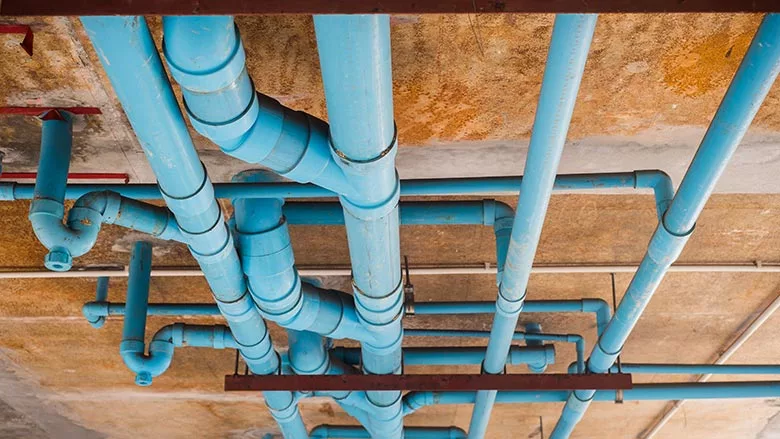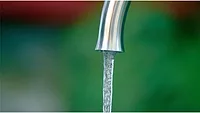James Dipping: A deep dive into water pipe sizing
Selecting pipe size is not as simple as looking at a chart.

There is a battle going on in the industry when it comes to domestic water distribution systems, and it lies in how plumbing engineers size domestic water piping. System longevity, pressure drop, water age, noise and building codes will influence the approach taken in sizing a domestic water system.
First, we need to understand the many functions of a domestic water system. Domestic water systems are used to provide clean potable water to plumbing fixtures, medical equipment, process water applications and mechanical uses. Domestic water systems bring water in from a municipal connection outside the building to many delivery points inside the building. Domestic water systems are pressurized water supply systems utilizing water pressure to “push” water thru piping to deliver to the required outlet.
Next, we need to understand what influences how we size domestic water systems. The most influential party will be the building code. It will establish the minimum required pipe size for a segment of pipe. This size will be a function of the connected fixture or fixtures downstream of the specific segment.
Building codes predominately use the Water Supply Fixture Unit (WSFU) method for determining a segment’s pipe size. The WSFU method is based on weighting fixtures in accordance with their water supply load-producing effects on the water distribution system. The National Bureau of Standards published BMS65: Methods of Estimating Loads in Plumbing Systems by Dr. Roy B. Hunter in the 1940s, which gives tables of the load-producing characteristics (fixture unit weights, see Table 6-7) of commonly used fixtures, along with probability curves that make it possible to apply the method easily to actual design problems.
Plumbing engineers must understand that water supply fixture units are dictated in the applicable plumbing code per fixture type. Water supply fixture units should be tabulated using tables within the applicable code for your specific project.
Plumbing engineers are obligated to follow the requirements of the building code. But doing so may have repercussions if thought is not given to the other factors mentioned above.
The WSFU method in many building codes is relying on data that is over 80 years old. Buildings, technology and plumbing fixtures are much different in modern times than in the 1940s. We have seen a significant reduction in water consumption at the fixture level established by the United States Energy Policy Act of 1992, and many municipalities enacting even more stringent requirements in recent years.
If we are sizing piping based on the performance and use of fixtures from 80 years ago, then how much larger is the pipe than it needs to be? This presents engineers with a new dilemma — water age. More specifically, water that is too old for its own good. Specifically, primary and secondary disinfectants are dissipating out of the water before it gets to the tap, which is problematic for biofilm and waterborne pathogen development.
Thankfully, we are seeing industry research to improve upon the WSFU method to include the use of smaller pipes. And we are seeing results, with the water demand calculator being implemented in some code language across the U.S.
The next question that needs to be asked is: “Can a pipe be too small?” The short answer is yes. System longevity, noise and pressure drop still must be considered in the overall system design.
Many materials will have velocity limits for water movement in a pipe. The velocity will be a function of the material and the water temperature. Commonly, the hotter the water, the lower the maximum recommended velocity is. And the difference can be significant. For example, the Copper Development Association recommends a velocity of 8 feet per second for cold water, but this velocity will be reduced to 3 feet per second for water over 140°. That is less than half the velocity, which has a huge factor in the flow rate in same sized pipe. Consider the example below:
Q = vA
Where:
Q = Volumetric Flow Rate
V = Flow Velocity
A = Cross Sectional Area (in this case, of the pipe)
The reason for velocity limitations is to avoid excessive noise and erosion-corrosion. Noise is a nuisance, whereas erosion-corrosion plays directly into system longevity. As engineers, we want to design systems that are reliable and long-lasting. Paying close attention to the maximum velocity in the piping network is critical.
If we looked at a 1-inch Type L copper tube, the Cross-Sectional Area of Bore (opening, not including wall thickness) is 0.825 square inches. Therefore, flow in a 1-inch pipe at 8 feet per second is 20.5 gpm, whereas at 3 feet per second, the flow will reduce to 7.7 gpm.
The reason for velocity limitations is to avoid excessive noise and erosion-corrosion. Noise is a nuisance, whereas erosion-corrosion plays directly into system longevity. As engineers, we want to design systems that are reliable and long-lasting. Paying close attention to the maximum velocity in the piping network is critical.
Pressure drop is another reason pipes should not be too small. If we took the same example of the 1-inch pipe above and looked at pressure drop based on 20 gpm versus 7 gpm, we would see losses of 0.096 psi/ft. vs. 0.018 psi/ft. In more generalized terms, for every 100 feet of pipe at 20 gpm, pressure losses would approximate 9.6 psi. In most cases, this level of pressure loss is detrimental to overall system performance and fixture operation, even if it is within the velocity limitations of the material.
Usage is another important factor that impacts proper water pipe sizing. If the usage at an outlet is high, water age is not as much of a concern. If it is low, we need to emphasize keeping the pipe as small as possible within appropriate velocity and pressure loss limitations.
Most of what we have discussed to this point has been water supply applications. But what about the return system? Energy codes and recommendations from OSHA and the CDC have changed how we approach hot water return systems. The overall consensus is that the water needs to be kept moving — and moving at a higher rate than in years past.
Engineers need to consider a few items when determining the size of the circulating system:
- What is my distribution start temperature, delivery temperature at the farthest fixture, and return temperature?
- What heat losses and flow rates/velocities do I need to maintain these critical temperatures? and
- Will these flow rates/velocities impact supply piping based on the considerations above?
Plumbing codes will not provide a fixture unit method for determining the size of hot water return piping. Energy codes will not provide criteria for what your temperature set points are. Hot water return systems are truly an engineering science where a balance is developed to right size piping, maintain temperatures and provide a long-lasting system.
When looking at pipe sizing holistically, it is easy to see the many challenges a plumbing engineer will face in selecting a pipe size. It is not as simple as “look at a chart.” All of the considerations noted above will affect the quality of the water, pipe size, user experience and the longevity of the building.
Looking for a reprint of this article?
From high-res PDFs to custom plaques, order your copy today!








